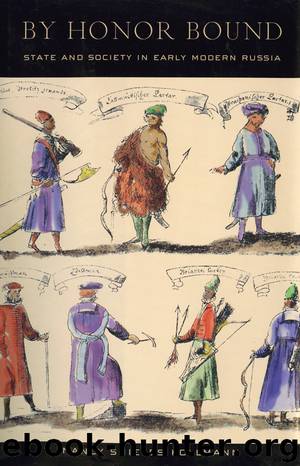By Honor Bound by Nancy Shields Kollmann

Author:Nancy Shields Kollmann
Language: eng
Format: epub
Publisher: CORNELL UNIVERSITY PRESS
Published: 2016-03-26T16:00:00+00:00
Precedence in Practice
To answer that question, I turn to litigation for evidence of actual practice. The source basis is a collection of 1,076 cases, which numbers about one-third fewer than the approximately 1,620 cases that Iu. M. Eskin has identified, but which is proportionally equivalent in chronological distribution.81 The database represents most cases from the published versions of military service musters, the principal Muscovite repositories of records of precedence disputes, and numerous archival cases.
Analysis of the patterns of almost two centuries of litigation is surprising and striking. In terms of historiographic interpretations, these patterns support Veselovskii’s and Presniakov’s understanding of Muscovite politics as patrimonial and discredit the ideas that the elite used precedence for upward mobility or that the autocrat was hobbled by it. Simply put, most of the time in precedence suits, plaintiffs lost and the status quo of clan hierarchy was affirmed. But, significantly, the tsar turned plaintiffs down in a variety of ways to cushion the blow (see the table), deftly limiting disaffection among losers and asserting his authority over the disposition of his men. Thus precedence was a quintessentially patrimonial institution, allowing the ruler to pursue policy while appeasing his men in the most personal and familiar of terms.
Of the 1,076 cases in the database, in only approximately 1% (14 cases) did the plaintiffs win outright, and four of these are associated with the Buturlin clan, whose precedence records have long been regarded with suspicion.82 That outright vindications were rare, however, should not imply that precedence did not satisfy litigants and resolve tensions. It did so in a more consensus-building fashion, often by preemptively removing the source of tension. In approximately 24% (254 cases) of the cases in the database, the tsar appeased the plaintiff without recourse to trial. Within that 24%, several expedients were used. Usually the tsar declared the disputed service relationship “without place” (“bez mest,” i.e., setting no precedents for future litigation); sometimes he reassigned the disputants without further need of a suit on the issues; and occasionally he declared the men equal (mestniki).83 Let us look at these strategies in turn.
Resolution of Precedence Cases
Download
This site does not store any files on its server. We only index and link to content provided by other sites. Please contact the content providers to delete copyright contents if any and email us, we'll remove relevant links or contents immediately.
| Anthropology | Archaeology |
| Philosophy | Politics & Government |
| Social Sciences | Sociology |
| Women's Studies |
The Secret History by Donna Tartt(18169)
The Social Justice Warrior Handbook by Lisa De Pasquale(11956)
Thirteen Reasons Why by Jay Asher(8458)
This Is How You Lose Her by Junot Diaz(6443)
Weapons of Math Destruction by Cathy O'Neil(5837)
Zero to One by Peter Thiel(5495)
Beartown by Fredrik Backman(5366)
The Myth of the Strong Leader by Archie Brown(5241)
The Fire Next Time by James Baldwin(5022)
How Democracies Die by Steven Levitsky & Daniel Ziblatt(4965)
Promise Me, Dad by Joe Biden(4909)
Stone's Rules by Roger Stone(4865)
100 Deadly Skills by Clint Emerson(4694)
A Higher Loyalty: Truth, Lies, and Leadership by James Comey(4554)
Rise and Kill First by Ronen Bergman(4547)
Secrecy World by Jake Bernstein(4390)
The David Icke Guide to the Global Conspiracy (and how to end it) by David Icke(4384)
The Farm by Tom Rob Smith(4328)
The Doomsday Machine by Daniel Ellsberg(4248)
